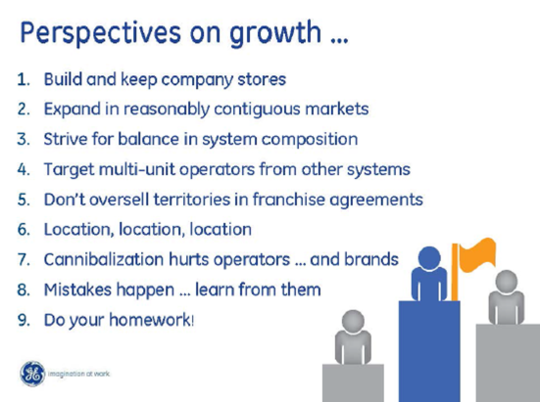
Two weeks ago, McDonald's (MCD) announced it planned to refranchise up to 1500 units out of Europe and Asia Pacific, and announced a series of increased dividends and share buy back plans. In 2013, Wendy's (WEN) announced refranchising of 450 units in its non core markets.
In 2012, Burger King (BKW) and Jack in the Box (JACK) kicked into serious refranchising, so much so that Burger King (BKW) now only owns and operates the 52 units in Miami out of a 13,667 worldwide unit total.
Even Starbucks (SBUX) is finally franchising its flagship Starbucks brand, refranchising units in the UK and Ireland. YUM has been furiously refranchising since the mid 2000s but intends to keep China Company operated.
Franchising has a high percentage margin--McDonald's has an 83% worldwide franchisee operations margin, and is among the highest. YUM's David Novak seems to confirm that when he says "we love franchising--it's the highest possible margin business we can be in. "
The debate in restaurant circles about the proper mix of company and franchised units has been legendary. In the 1970s and 1980s, the trend was towards company owned locations. In the 1990s, as return on invested capital (ROIC) and awareness of free cash flow--profit less capital expenditures-- expanded, refranchising picked up.
See GE Capital's presentation slide below, from a presentation Managing Director Todd Jones gave last week, which has some telling comments on this topic:


Refranchsing means the company thinks it can make more on the royalties, and on rent surcharges (if it owns the real estate) and by reducing G&A and capital expenditures (CAPEX), versus operating the unit.
In my view, most times, refranchising involves weaker profit stores, lower than a magic profitability toggle point and typically involves weaker brands or weaker geographies in a brand.
Therefore, investors may like it, especially in the short term. But who is it good for?
Benefits of refranchising
- Refranchising can be a stock catalyst, that is, it is some corporate new news, particularly if it funds increased dividends or buybacks, or if it is associated with more debt that can fund dividends or buybacks, that juices the stock. That what McDonalds is doing.Optical improvement of the numbers: refranchising takes the lower units out of the base, and optically makes restaurant sales and margins improve, as both Wendy's and Jack in the Box have noted.
- Refranchising should lower debt, to allow for special dividends or to improve credit ratings, to ultimately lower interest expense.
Wall Street hopes refranchising will smooth out earnings variability and will shelter the franchisor from food cost and labor inflationary forces.Boost Return on Invested Capital (ROIC) metric: with unit sale proceeds and capital investment falling lower or to near zero, it provides a bump to ROIC, at least in the short term.It can help out franchisees, as large franchisees have a need to get larger. This was the case in the 2013 Wendy's refranchising.And, in some cases, if the company can't operate stores well, refranchising is a type of outsourcing of the problems, to others. Both YUM (KFC) and Burger King (BKW) have admitted franchisees operate more efficiently.Limitations with refranchising- Over time, the ultimate risk is the company becomes an outsourced restaurant provider--no expertise in running restaurants.Adaptability/flexibility hampered: franchised concepts take longer to get new products to market and keep the physical plant remodeled and renewed. In the US, Starbucks will always have an advantage over McDonalds as it can make decisions and implement market change quickly, while in McDonalds case it takes years to attain buy in and effect market change.Franchisees live a narrower existence. They do have to pay a royalty and are generally territory constrained. In addition, the availability of funds and cost of debt for franchisees typically are unfavorable versus that of the franchisor. This implies higher cost of debt and missed opportunities. Franchisees have higher debt to EBITDA ratios. For example, the McDonalds 2013 US franchisees debt /EBITDA ratio is app. 5.4 times, versus about 1.4 times at MCD corporate. Higher debt=higher risk=higher cost.As the franchised ratio increases, investors get less visibility. Restaurant franchisors universally avoid talking franchisee performance. Currently, Popeye's (PLKI) is the only publicly traded chain restaurant franchisor reporting its franchisee's profits quarterly--a EBITDAR number, which isn't perfect, but that is something.Decreased company structure. Good franchisors run their company units as a training and development ground for franchisees. If the company store base is deteriorated or nonexistent, quality development staffing comes at risk.Once the refranchising is done, that arrow is no longer in the quiver. What next?The Bottom Line
Business is business. Every number and signal needs to be scrutinized. Refranchising is both a bullish and bearish indicator at the same time. It is not a panacea.
Ironically, in reaction to the McDonald's plans last week, Wall Street was not happy. They hoped for more catalysts to juice the stock higher.


Leave a comment